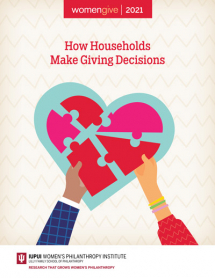Women Give 2021 has first new data in 15 years on household charitable giving decision-making
The Women’s Philanthropy Institute today released Women Give 2021: How Households Make Giving Decisions, which explores charitable giving decision-making in the general population. The report analyzes the first new data on this topic in 15 years, and finds that 61.5% of couples make giving decisions together — a number that has declined from 73.4% in 2005. When one partner in the household decides, women are more likely to do so.
Women Give 2021—which is funded by a grant from the Bill & Melinda Gates Foundation—found that couples who decide together about charitable giving are typically older and have children, while younger couples are more likely to decide separately or have one partner make the decision for the household. The report suggests this may be due to couples marrying later and entering the relationship with preferred charitable causes, in addition to shifting gender roles within couples. Among sole deciders, individuals have varying thresholds for how much they will give without consulting their partners; this amount is much higher for men compared to women.
“Women Give 2021 has significant implications for the philanthropy community; the findings signal the importance of understanding the dynamics of household decision-making as gender roles continue to shift and evolve. For nonprofits, this is an opportunity to rethink how they engage every member of the household in conversations about giving and impact,” said Jeannie Sager, director of the Women’s Philanthropy Institute.
The report adds new dimension to research on this topic by exploring comparisons in household decision-making. When looking at different types of household financial decisions — such as long-term financial planning, paying taxes or buying groceries — charitable giving decision-making is most similar to short-term financial management, except that more households use separate decision-making about giving. This comparison suggests that many households see charitable giving as a subset of short-term financial decisions.
Most couples make giving decisions without any outside consultation. Only 1.1% have ever talked about giving with a financial or philanthropy advisor.
“Giving has the potential to bring households closer together, especially when partners are strategic and intentional about their philanthropy. Women Give 2021 presents an opportunity for families to connect over shared values, explore how they give, and embrace the joy that comes with giving. The report also provides donors and advisors with actionable insights to inform household giving and ensure it has the greatest impact possible,” said Debra Mesch, Ph.D., professor of philanthropic studies and Eileen Lamb O'Gara Chair in Women's Philanthropy at the Indiana University Lilly Family School of Philanthropy.
Women Give 2021 is the 12th in a series of signature research reports conducted by the Women’s Philanthropy Institute that focus on gender differences in giving to charitable organizations. Each report explores unique questions about the factors that shape gender-based giving patterns — including age, religion, income, marital status and more — in order to increase understanding about how gender influences philanthropy.
Additional key findings from Women Give 2021 include:
- More than six out of 10 couples make charitable giving decisions jointly (61.5%). When one partner makes decisions for the household, women are slightly more likely to do so than men (15.3% and 12.1%, respectively). The remaining couples (11.1%) decide separately.
- Compared to other types of household financial decisions, charitable giving is most similar to short-term financial management, although more households make giving decisions separately.
- Certain demographic characteristics, such as age, religiosity, and couples’ educational differences, are associated with how households decide about charitable giving.
- Charitable decision-making is related to the average amount households give. On average, man-deciding households give the most, and separately deciding households give the least.
- Individuals have varying threshold amounts for giving without consulting their partners. Couples who decide separately, or where men solely decide, have the highest threshold for giving without consulting their partners; couples deciding jointly, or where women solely decide, have much lower thresholds for consultation.
- Most households report that they are satisfied with their charitable decision-making, and partners broadly agree on their giving; around three-fourths of couples agree about the amount and recipients of their giving (74.6% and 77.5%, respectively).
About the Women’s Philanthropy Institute
The Women’s Philanthropy Institute (WPI) is part of the Indiana University Lilly Family School of Philanthropy at IU Indianapolis. WPI increases understanding of women’s philanthropy through rigorous research and education, interpreting and sharing these insights broadly to improve philanthropy. By addressing significant and groundbreaking research questions and translating that research into increased understanding and improvements in practice, WPI helps to leverage new and expanded resources for the common good.
About the Indiana University Lilly Family School of Philanthropy
The Lilly Family School of Philanthropy at IU Indianapolis is dedicated to improving philanthropy to improve the world by training and empowering students and professionals to be innovators and leaders who create positive and lasting change. The school offers a comprehensive approach to philanthropy through its undergraduate, graduate, certificate and professional development programs, its research and international programs and through The Fund Raising School, Lake Institute on Faith & Giving, the Mays Family Institute on Diverse Philanthropy and the Women’s Philanthropy Institute. Follow us on Twitter, LinkedIn, or Instagram, and “Like” us on Facebook.


